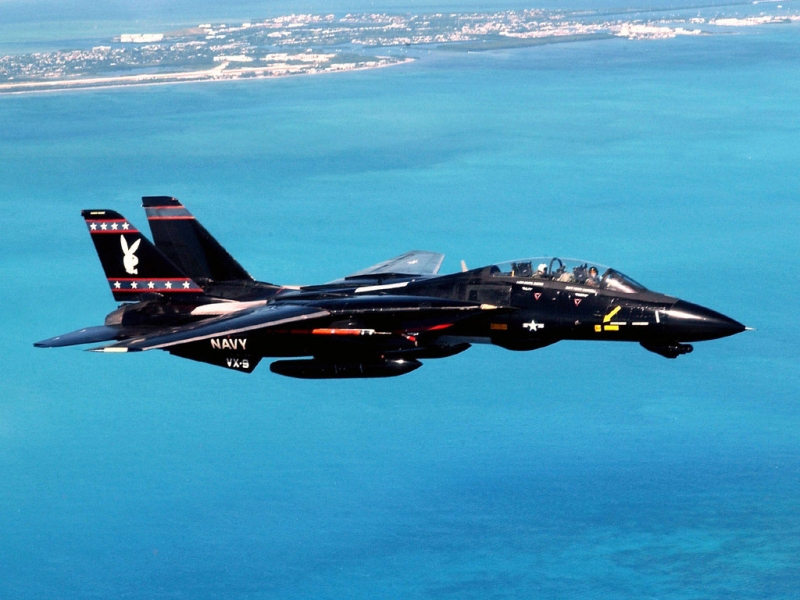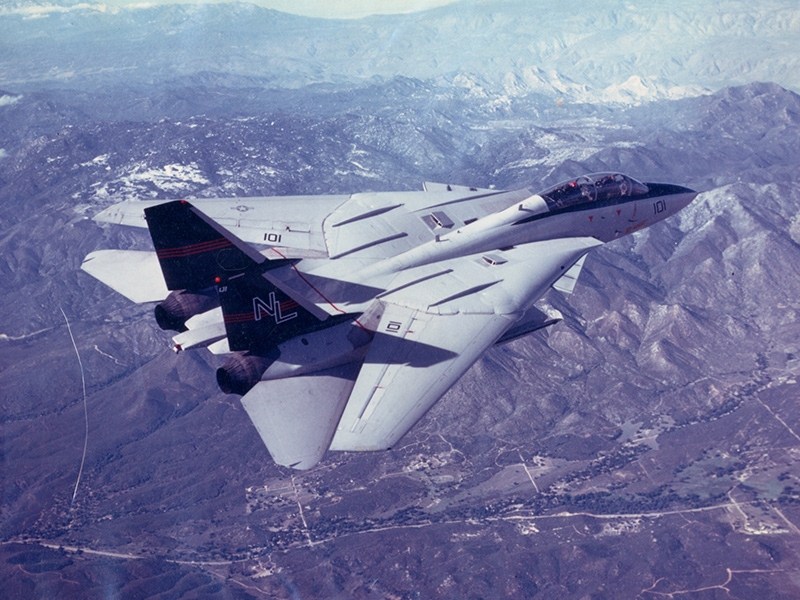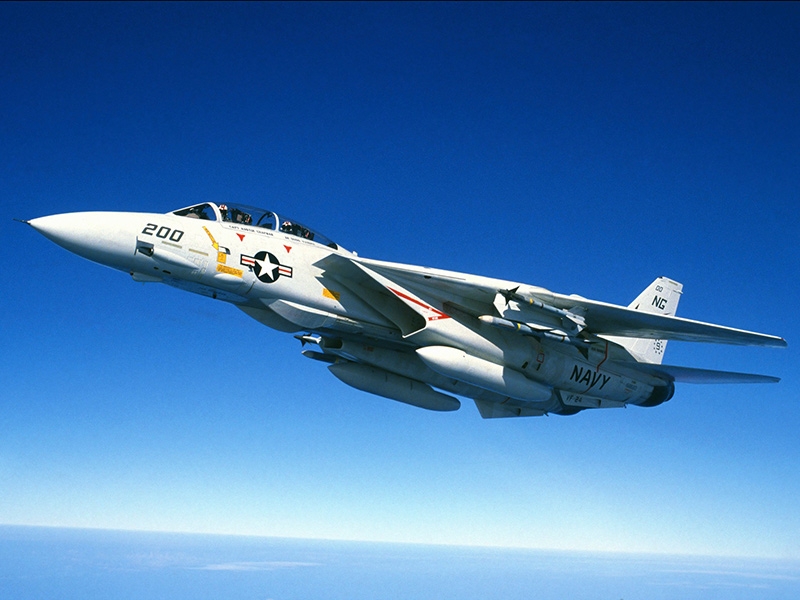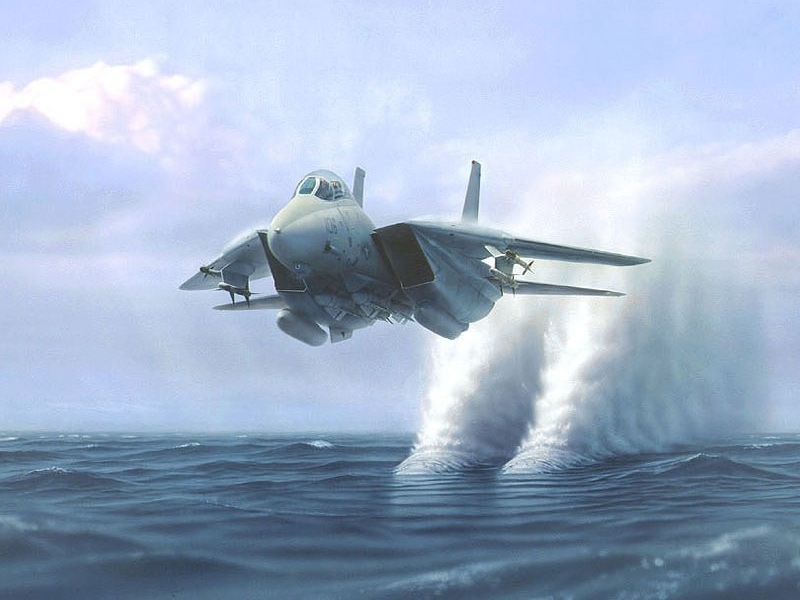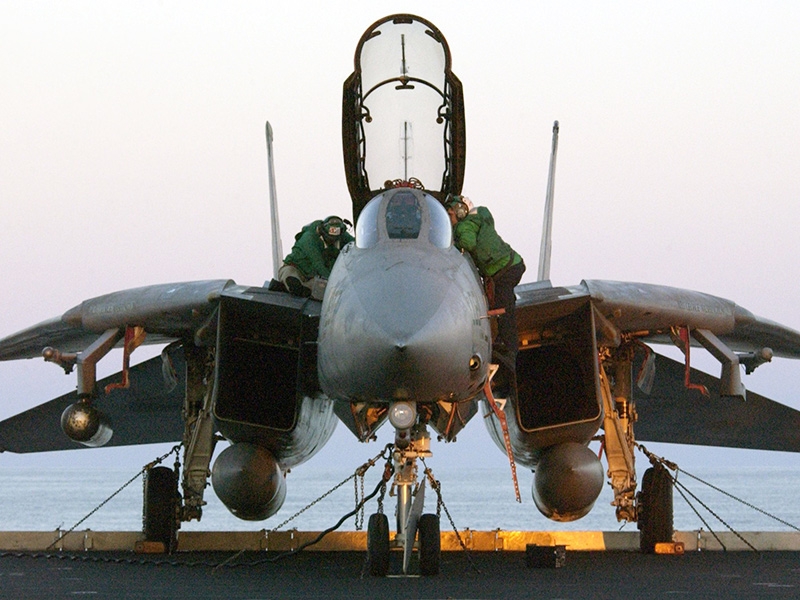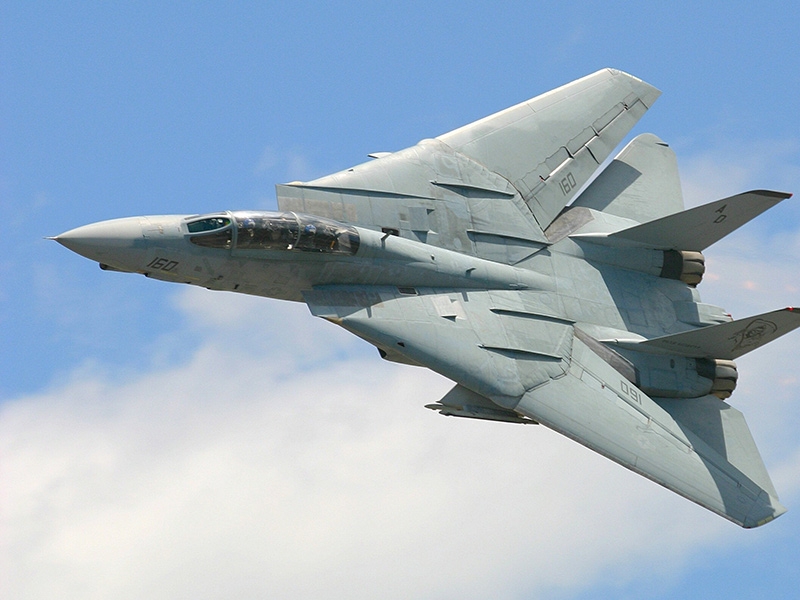
Grumman F-14 "Tomka" (English. Grumman F-14 Tomcat) - Double jet fighter-interceptor of the fourth generation with variable geometry wing, производства Grumman Aircraft Engineering Corporation. Developed in the early 1970s to replace the US Navy F-4 fighter "Phantom» II. Armed with 1974 of the year. Withdrawn from the US Navy weapons in 2006 and zamenёn of F / A-18E / F Super Hornet. It is exported to Iran and there is armed now.
F-14 Tomcat – video
In the late 60's in the United States began designing driving deck interceptor to replace F-4 "Phantom-2". In the final of the competition was a project of McDonnell Douglas and Grumman. The firm McDonnell Douglas was a machine design with fixed wing, while the wing sweep Grumman changed.
After the air battles over the territory of Vietnam, the military wanted, developers to laying planes created in the vertical and horizontal characteristics of maneuverability not worse than the MIG-21, which at that time was the main rival of the US Air Force air combat aircraft.
In the theory of variable wing geometry should give acceptable performance takeoff and landing at high mass, as well as good maneuverability in close quarters, high maximum supersonic speed of interception and a long patrol.
It was therefore quite natural, what 3 February 1969 , signed a contract to build a fighter F-14F with the company Grumman. The plane was given its own name, "Tomcat", reflecting the tradition of Grumman fighters give their sea names of different cats, but this time accidentally mingled with Vice Admiral Tom Connolly - Deputy Chief of Command Marine Aviation Operations, who was very enthusiastic about the project. At an early stage of F-14 was called "The Cat Volume" – «Tom’s cat», but with time it was transformed into «Tomcat».
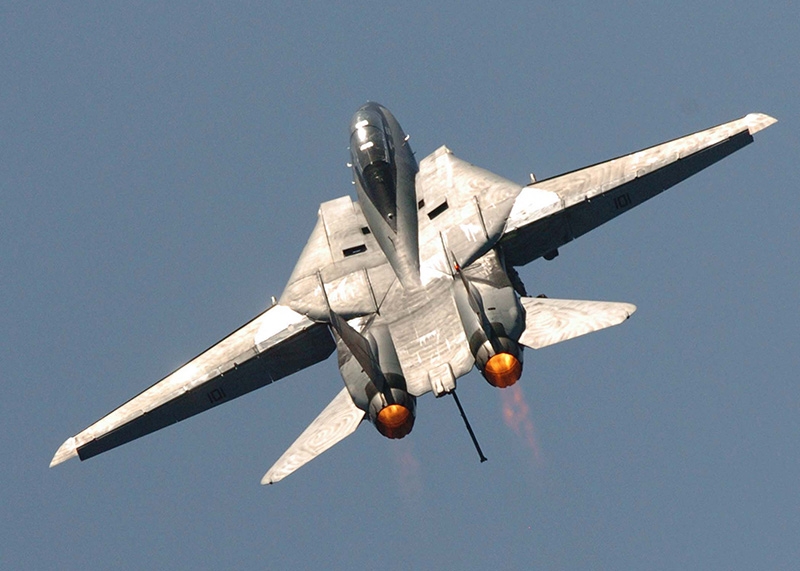
Outside view of the new aircraft was finally formed by March 1969 of the year. The designers removed a tail and two folding ventral keel, replacing them with two-keel tail. This was to give the best stability in the event of failure of one engine. Besides, in plane view a large influence of the revolutionary Soviet MiG-25.
Aircraft development pace ahead of the projected promising engine for him. Therefore, temporarily at first experienced "Tomcat" put Pratt & Whitney turbofan TF30-P-412A. The basis of these engines were turbofan TF-30-P, mounted on the F-111 strike aircraft and A-7. But even increased to 9070 kg of thrust is not enough for a heavy fighter. Another problem became unsatisfactory stability and motor acceleration TF-30 during maneuvering energetic yield at high angles of attack.
Problems with power units all the time appeared the "Tomcat". About 28% all crashed F-14 have been lost for this reason,. According to the American F-14 pilots to cope with the tasks, but requires careful piloting, in some cases flights with low speed at high altitudes can be risky.
During the fifteen years for the F-14 engines are trying to find a more suitable, but the problem was resolved only by the end of the 80s, after installation of the engine GE F110-GE-400, which is equipped with the F-15 and F-16. Process re newer engines place over 1988-90 years. And in 1990-93 respectively launched the production of yet another version of the "Tomcat" with the F110 turbofan and advanced avionics -F-14D.
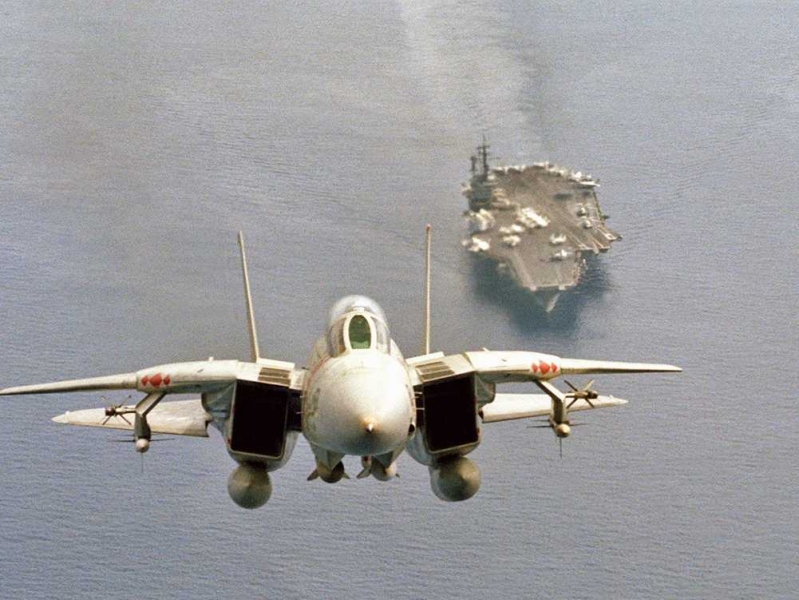
The minimum span of the wing of the aircraft was 11.65 m, and the maximum 19.54 m. Length - 19.1 m, height - 4.88 m, wing area -52.49 m2. Empty weight was 18100 kg. Cruising speed 740 – 1000 kmh. Practical range - 2965 – 3200 km.
In service has been built one 20-mm gun M61A-1 on 675 shells, located in the forward fuselage. Combat load was 6500 kg eight hardpoints.
Under the fuselage could accommodate 4 AIM-7 Sparrow – SD semi-flush medium-range position, or 4 AIM-54 Phoenix - UR long range on special platforms. Also can be suspended 2-4 AIM-9 “Saydvinder” or AIM-120 AMRAAM - SD near field. The combat potential of the machine determined the weapon control system Hughes AWG-9.
The most long-range air-to-air SD "Phoenix", coupled with the unique MSA did not very successful aircraft by one of the best interceptors of the time.
At the time of its creation, a guided missile AIM-54 “Phoenix” long range was unique, she did not have analogues. The main feature - a combined guidance system, wherein the combined autopilot initially and semiactive radar guidance in the middle section guided on the active end portion: about 16-20 km. There was also a passive guidance mode for any source of electromagnetic radiation, for example, Radar anti-ship missile or aircraft.
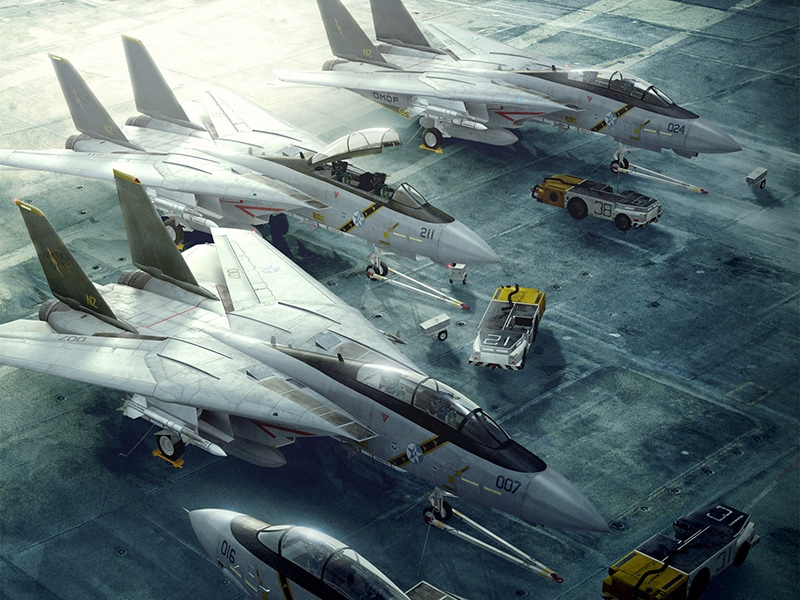
At missiles "Phoenix" maximum launch range was 160 km, at high altitude missile velocity reached M = 5. Rod warhead had a blast radius of about eight meters, providing infrared undermining, contact or radar fuze.
In the process of development and refinement of the JMA and rockets there were big difficulties, so the rocket "Phoenix" does not immediately become the main weapon of the aircraft. partly, because of the high cost of one missile - about 500 thousands of dollars in the 70s.
In the end,, Navy counted, that they need a "long-armed" Interceptor, therefore alternatives to the "Phoenix" was not. Another factor in favor of the "Phoenix" – other missiles “air-to-air” could not intercept the MiG-25 at high altitudes.
The contract for the establishment of the first batch of 26 aircraft signed in October 1970 of the year. 12 aircraft were in flight test program. There were also losses. 30 December 1970 , the first accident of this type of machine, but the pilot ejected.
The result of the flight tests of the aircraft group summed Navy pilots, test consisting in the squadron VF-124. According to their commander Frank Shlantsa, aircraft demonstrated good flight characteristics and could potentially be used to achieve air superiority, as well as air defense ship connections.
note, during test flights broke two more aircraft. 30 June 1972 year pilot crashed Bill Miller, manages ten prototype during a demonstration flight over the Patuxent River Air Base. Cause of the accident is not clear so far. Just a couple of weeks before his death, Miller flew to the "top ten" on board the aircraft carrier "Forrestal". 28 June, he first sat on the aircraft carrier.
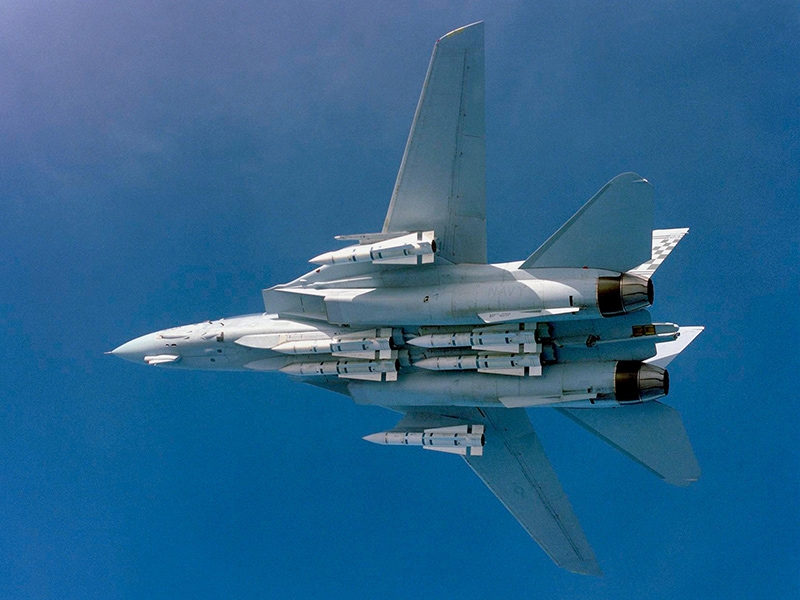
20 June 1973 year, another plane was lost, at number five, initial start-up of SD "Sparrow". The missile came down from their horizontal guides, hitting fuel tank, located in the central part of the fuselage. As a result, there was an explosion and fire. But since there was no rocket warhead, the pilot and the operator has successfully eject.
In April 1972 the year began testing complex of the F-14 / UR “Phoenix”, under which resets the weight and dimensions rocket layouts, hanging on "Tomcat". And in July 1972 year happened milestone: during execution of the aircraft / missile "Phoenix" system has successfully hit the target AQM-37A “Stiletto”, which simulates the MiG-25. The starting point was at an altitude interceptor 14 300 speed meters for M = 1,2 at a distance 65 away from targets.
Another significant event - the simultaneous launches of guided missiles at several targets. In mid-December 1972 g. It was first held simultaneous launch of two missiles “Phoenix” two targets, simulating Soviet RCC X-22.
In the future missile launches were made against targets, creating interference and simulating another threat from the Soviet Tu-22M - bomber, famous in the West, as the MiG-25. In April 1973 the crew of the "Tomcat" managed to find the target BMQ-34, which imitated "Bekfayr" at a distance of 245 kilometers, and then wipe it away 134 kilometer from the trigger point "phoenix" missiles. And in November 1973 year pilot John Wilson and weapons operator Jack Hover managed to seize six targets at once. In the US press, this episode was called "record". For about forty "Tomcat" second launched six missiles at six different purposes, who were at a distance from the 80 to 115 kilometers. Four missiles successfully hit the targets, at one refused machinery, and a launch was considered a failure due to the target fault.
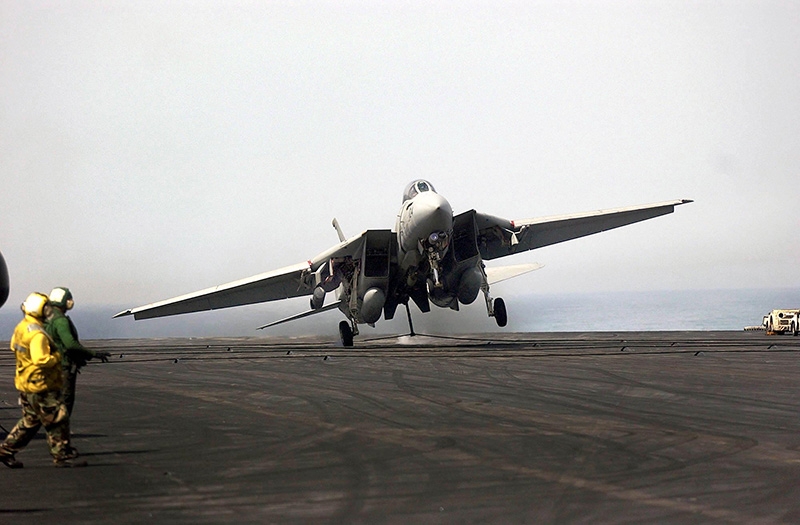
However, the new weapons systems were considerable shortcomings. Firstly, the system is difficult to master and exploit. Secondly, the high cost of one missile. To 1975 The missile is launched, the most experienced crews. A check of the conventional front pilots as much as close to combat conditions conducted on a three-day exercise, which involved first wing aircraft carrier deck "John F. Kennedy ". The crew of F-14A as a part of the operator and pilot Lt. Kraal Lieutenant Andrews managed to shoot down a target CQM-10B “Bomark”, which simulates the MiG-25. true, it was only a theoretical check possible use of guided missiles ordinary crews. Only a very small number of combatant pilots and operators were able to launch guided missile AIM-54. "Phoenix" the cost was too high, to use it during combat training.
but, if a "long arm" of the F-14 was all right, the conduct of air combat maneuvering was not so smooth. For, to lead an offensive dogfight, from fighter to be a decent thrust-weight ratio, What was lacking in the F-14A. According to some experts and pilots, "Tomcat" was necessary 30% increase in engine thrust. It leaves much to be desired and horizontal maneuverability, several aircraft fell due to the release in a flat spin during training exercises. As it turned out, exit at high angles of attack aircraft begins to lurch and prowl.
If these speeds at the same time to use the rudder and differentially deflectable stabilizer, inherent to the control system, then there are very high angular velocities, which contributes to the care in a tailspin.
In this regard, the question arose of whether to extend the life of multipurpose aircraft F-4 and the need to start the development of carrier-based version of the F-15 machine.
As a result, the admirals decided to create a small mixed fleet, simple and cheap, and heavy, complex and expensive, fighters, following the example of the BBC. These conversations stimulated the development of multipurpose fighter F-18 "Hornet".
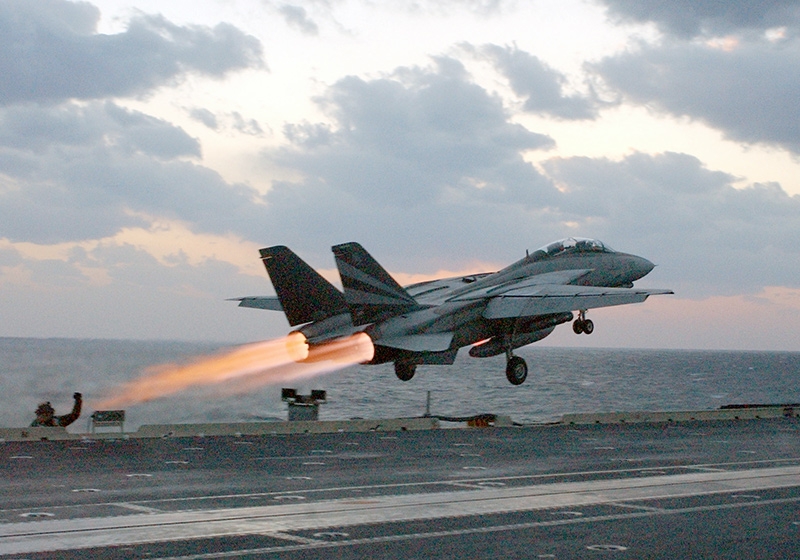
The first two drill squadron was assigned to the nuclear aircraft carrier "Eisenhower". In his first voyage to the "Tomcat" ship went 17 September 1974 of the year. During campaign time, pilots have flown 2900 hours on the F-14, committing a total of 1600 landings and takeoffs on deck. 460 It was carried out at night. During this operation, and the first accident occurred - 2 of January, one of the "Tomcat" on fire engine, but the crew managed to eject. Aircraft also participated in the Vietnam War, blanking out the Americans from Saigon.
Typical tasks deck F-14 - is the interception and patrol. Usually a couple of planes patrolled about fifty minutes away 550 kilometers from the aircraft carrier. In combat "Tomcat" was four load controlled "Phoenix" missile, Two more "Sparrow", Two «Saydvinder», and two PTB, capacity of which was 1060 liters. If the fighter took off to intercept, something similar to the cargo was on the external sling. When airspeed M = 1.5 combat radius reached 247 kilometers.
The second aircraft carrier, received the "Tomcat" – "John F. Kennedy ». AT 1976 year on combat duty on the aircraft carrier "America" have taken up two "Tomcat" Squadron. aircraft entering peaked in 1977 of the year, when they appeared on the aircraft carrier "Kitty Hawk", «Konstelleйshn», "Nimitc".
Total "Tomcat" armed 22 deck squadron, as well as two training squadrons and four reserve. it was released 557 Machine F-14F, including 79 for the Iranian Air Force and 12 experienced, and 38 Units F-14B, 37 F-14D.
After entering the unit with the "Tomcat" started to happen, flight incident. For example, I had to twice stop flying machines of this type, after two accidents at intervals of two days 21 and 23 June 1976 of the year. After thorough investigations, and inspections of all aircraft situation has not changed. 14 September one of the planes crashed into the water at take-off, sank to melkovode, next to the ships of the Soviet Navy. unknown, what kind of reaction on the plane it was the Soviet military, but the Americans have launched a frantic activity, to prevent possible enemy to raise the plane. In the area of disaster came a rescue ship and two tugboats. The aircraft was able to pick up and deliver for inspection on the territory of the British bases Rozayt. Rockets from the plane took off at the bottom, with the help of US Navy research submarine NR-1. By the middle 1984 year happened more accidents and disasters from 70 fighters. The main reasons appeared in the stall corkscrew and fire engines.
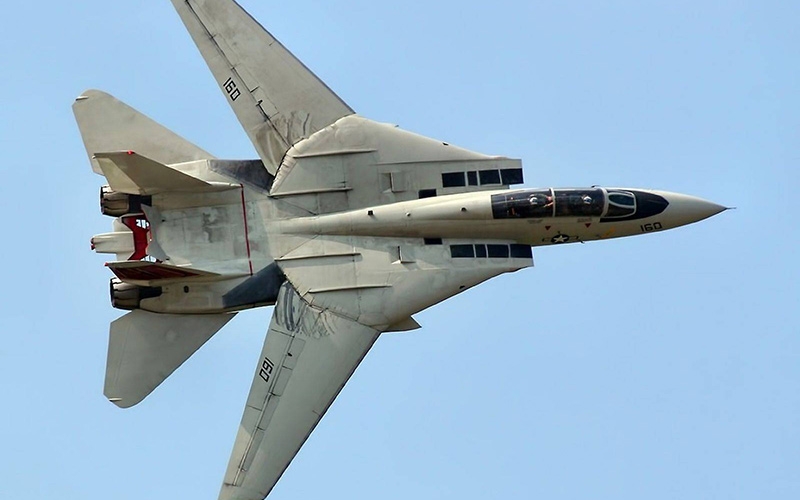
In addition, the observed low reliability of material support of new aircraft, engines were unreliable. Aboard the aircraft carrier was, least, eight TF-30 turbofan, which we were to replace the defective. Normal combat readiness - it 8 of 12 "Tomcat".
The F-14 the actual fighting came at the end of summer 1981 of the year. US aircraft carrier "Forrestal" and "Nimitz" subjected to overflights of Libyan MiG and Su. During one of these two "Tomcat" from the squadron VF-41 shot down two Su-22.
There were casualties. in winter 1982 , the Syrian air defense system destroyed three "Tomcat", who was accompanied by attack aircraft A-6 for strikes at various targets on Lebanese territory. Six carriers were involved in the operation "Desert Storm". Four of them were F-14. "Tomcat" accompanied by attack aircraft, perform reconnaissance sorties. "Tomcat" managed to shoot down an Iraqi helicopter. Iraq's air defense, in its turn, shot down one "Tomcat".
Judging by the experience of combat use "Tomcat", it can be concluded, that the aircraft was unable to solve the tasks assigned to it, special, when analyzed according to the criterion “cost-effectiveness”. The biggest win F-14s flew over the area of the Gulf of Sidra in the fighting with the Libyans. The conditions were almost polygon, no maneuvering was not fighting.
Many experts doubt the feasibility specifications, who said Americans.
Judging by the report, which was prepared for the US Congress, it is impossible to accurately predict the likelihood of AIM-54 missiles hit due to lack of statistics launches in real conditions. Americans have invested a lot of money in the development version of AIM-54C, which could intercept low-altitude targets with RCS about 0.5 m2. But even she had difficulty intercepting low-altitude cruise missile, wherein a rate of M = 3.
After the completion of the "cold war" and the final degradation of the Russian naval aviation in the early 2000s it began a gradual withdrawal "from the Tomcat US Navy. They changed the jack of all trades "Superhornet".
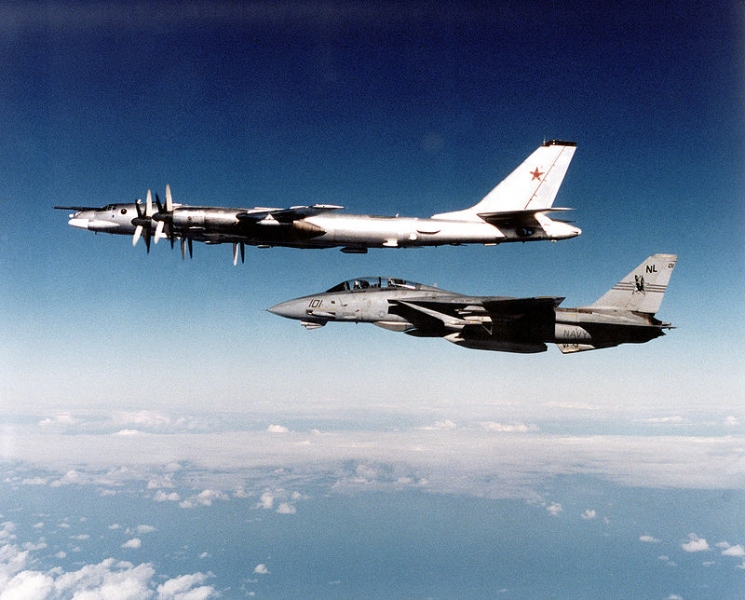
F-14 is accompanied by the Soviet strategic bomber Tu-95, 1991 year
options
YF-14A – Prototypes and pre-series aircraft. constructed 12 copies.
F-14A – Double-weather fighter-interceptor for the US Navy. Later in the armament precision-guided munitions have been added. In the US Navy were delivered 545 Flight. recent 102 aircraft were equipped with improved engines TF30-P-414A.
In Iran planned to send 80 Flight, however, only it has been delivered 79; 80-th Iranian plane was in the US Navy.
F-14A + or F-14B – The improved version of the aircraft F-14A with GE F110-400 engines. Most of the equipment, including the AWG-9 radar, It left unchanged. A + was separate from the display device HSD-warning system for irradiation in the cockpit. Later I received the designation F-14B. There were built 38 F-14B aircraft, yet 48 It has been converted from version F-14A. At the end of the 90s in 67 F-14B was extended life of the airframe and improved avionics, in particular, the new HUD SPARROWHAWK. The modified aircraft were designated F-14B Upgrade.
F-14D Super Tomcat – Last modification of the F-14 with GE F110-400 engines. Analog onboard equipment has been replaced by digital, also new radar APG-71 has been installed. Was built 37 modification of aircraft F-14D, yet 18 It has been converted from version F-14A.
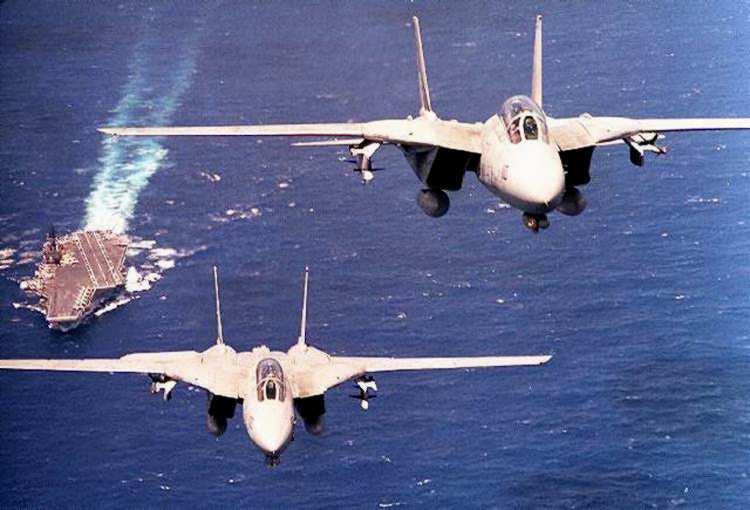
combat application
F-14 was adopted by the US Air Force in September 1974. American "Tomcat" participated in two clashes with Libyan aircraft over the Gulf of Sidra, knocking at 1981 two year Su-22, and 1989 year - two MiG-23.
In September 1980 the American F-14 shot down an Iranian fighter "Phantom".
8 August 1987 , an Iranian F-4E «phantom» unsuccessfully fired a missile AIM-7 on the American patrol aircraft P-3C, in response to American "Tomcat" escort fired two AIM-7, but also missed two missiles.
F-14s took part in the operation "Desert Storm" (1991), which provided air cover by American bombers and attack aircraft. One "Tomcat" was shot down by an Iraqi SA-75.
In subsequent conflicts ("Reasonable force" operation (1995), War against Yugoslavia (1999), War in Afghanistan (2001) and Iraq) F-14s were used to attack ground targets.
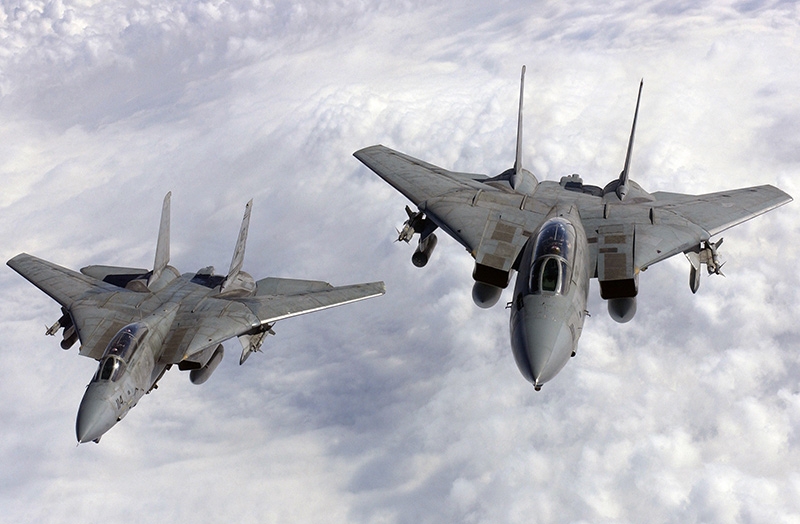
Iran-Iraq War
Iran was the only country, where to export F-14, it was ordered 80 Flight. All were delivered to the Air Force of Iran 77 Flight, two more crashed during the tests and one transferred to the US Navy (s / n: 160299-160378 (3-863 – 3-892, 3-6001 – 3-6050)). They took part in the Iran-Iraq war. Despite the problems with spare parts, "Tomcat" is still operated by the Iranian Air Force.
Iran ordered 80 fighters with weapons and spare parts 1974 year. The entire park aircraft began service three years later, It was trained by this time more 120 crews and almost the same number of ground staff. Despite the Islamic revolution 1979 of the year, as a result of which all relations with the US were terminated, Iranian Tomcat remained combat-ready.
A year later, Iranian F-14s took part in the war against Iraq and become the only fighter 4th generation to actively participate in the war. Against ground targets interceptors were hardly used.
AT 1980 , Iranian F-14 shot down several Iraqi aircraft, lost in aerial combat only 1 destroyed "Tomcat" and 3 seriously damaged.
AT 1981 , an Iranian F-14 was shot down over the island of Kharg their SAM HAWK. Anti-aircraft gunners claimed that they interfered with flying nearby American E-2A «AWACS" and it seemed to them that they were shooting at Iraqi MiG-25. In the same year, the anti-aircraft gunners shot down one more "Tomcat". AT 1984 The same SAMs shot down an Iranian "Tomcat". Total anti-aircraft gunners of the same Iranian SAMs claimed three kills and 1 damaged Iranian "Tomcat".
In October 1981 , Iranian F-14, first met in battle with Iraqi Mirage F1 fighters. During these meetings, it was shot down three "Mirage". In turn, in November, the Iraqi "Mirages" shot down three Iranian "Tomcat".
F-14 successfully fought Iranian statements to the MiG-25 Iraqi intelligence high-speed. for the first year only (1982) active use of the MiG-25, the Iranians claimed downing of four "MiG". According to other sources the first combat loss of an Iraqi MiG-25 took place only in 1985 year. According to the latest Tom Cooper Iranian F-14 claim only 1 downed reconnaissance MiG-25RB. 1 "Tomcat" was seriously damaged in a battle with the MiG-25PD. Also, F-14 competed effectively with Iraqi strike aircraft; in particular, Only in the fighting in October 1980 It had been destroyed by "Tomcat" 1 to 11 fighter-bombers MiG-23BN. According to the US Department of Defense data in 1983 Iraqis, the Soviet Union sent to the wreckage of downed "Tomcat" and missile AIM-54A.
11 August 1984 F-14 met with the new Iraqi MiG-23ML, in the "Tomcat" battlefield was hit by a missile R-60. Iran declared 35-45 air victories F-14, though some Western scholars believe that the Iranian command recorded a large number of victories fighters aerial victories at the expense of anti-aircraft gunners, or in general did not consider. Undefined Western sources say 4 confirmed victories at 4-5 losses in dogfights. according to Mr.. Ivanov and airvectors.net, documentary evidence have only 3 Iranian aerial victories (2 mirage and 1 MiG-21), however, these data are obviously incomplete - for example, documented the shooting down Iraqi MiG-23 10 November 1980 of the year. After the book Tom Cooper and Farzad Bishop, based on Iranian sources, according to 2004 year nine F-14s were lost in combat, seven incidents broke in and at least eight were in serious damage. According to the latest data of the Iranian 11 F-14s were lost in combat, 7 it broke, 1 It was hijacked and 8 It was heavily damaged, of 77 by the end of the war left 58.
The postwar study of some researchers use F-14s to Iran talks about other statistics. From these data, the Iranian F-14 gained 111 confirmed victories and 49 unconfirmed. It is also a victory was won over the MiG-25RB jointly by F-14 and F-5. These statements raise serious doubts.
In the operational state of the first days of the war we were all of 77 "Tomcat". In the middle of the war participated in the parade 25 F-14A. By the end of the war the number of combat-ready aircraft was 7-9. On average, during the war because of the lack of spare parts 4-5 F-14 was able to carry out combat missions, Iraq declared the destruction of more than 70 "Tomcat", that is, the vast majority of available planes in Iran, but after the war ended, Iran still had 58 "Tomcat".
During the war, there have been several defections of Iranian pilots. AT 1986 , one F-14 was hijacked in Iraq. There is information, that one or more F-14A were delivered to the Soviet Union in exchange for technical assistance. Also, At least one crew "Tomketa" together with the plane deserted in the "Land of the Soviets". The Iranians vehemently denied that the supplied F-14 for the USSR.
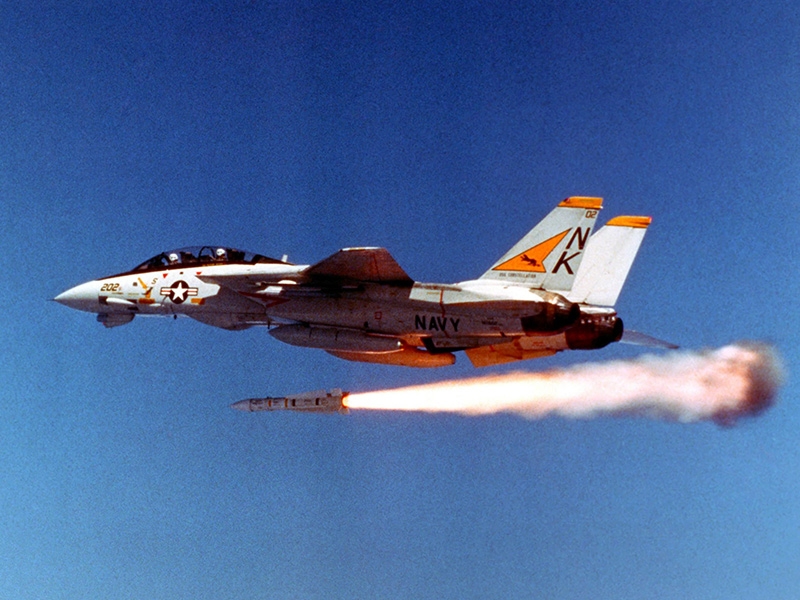
Decommissioning
Initially the F-14, the ending operation has been scheduled for 2008 year, but the successful commissioning of fighter F / A-18E / F Super Hornet allowed to do so before the deadline.
F-14 has officially withdrawn from service of the US Navy 22 September 2006 of the year, the last flight of the squadron VF-31 and VF-213, equipped with the F-14D, committed 10 March of the same year, and all the planes A and B models were put in reserve even earlier.
additional facts
– On the F-14 aircraft Kara Haltgrin, the first in the history of the US Navy Woman, received a qualified fighter pilot. She was killed in a plane crash 25 October 1994 of the year.
– Highest pilot F-14 - Iranian Zandi Al Jalil (1951—2001), shot down 11 enemy aircraft, including unconfirmed, among which 4 Mig-23, 2 Su-22, 2 Mig-21, and 3 Mirage F1 during the Iran-Iraq War, who was killed in a car accident in 2001 year.
– Driver F-14 feature film Top Gun was filmed c Tom Cruise in the lead role.
– F-14 appears in "The Last Countdown» movies, «Asteroid», "Revenge", "Shot Liberty" and "Turbulence"
– Documentaries - «Speed and Angels», "Famous Aircraft - F-14 Tomcat»
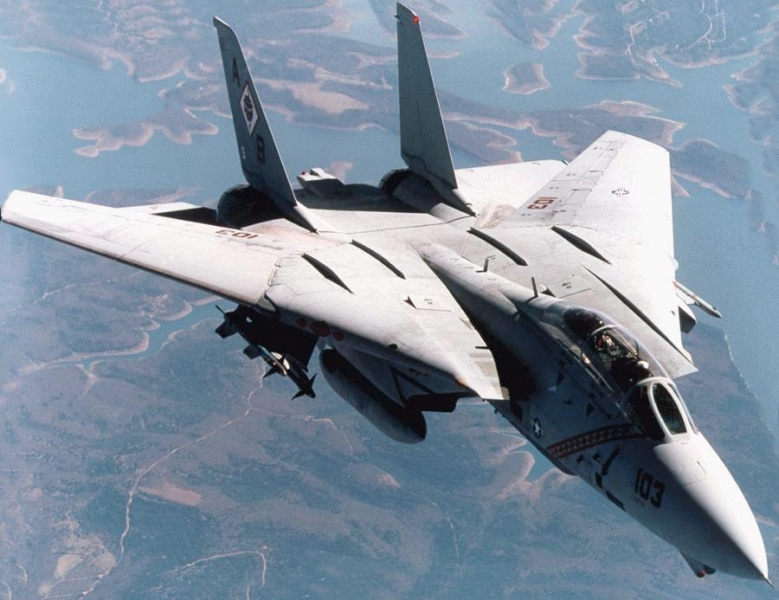
The performance characteristics of F-14
The crew of F-14
– 2 man (pilot and weapons operator)
Dimensions F-14
– Length: 19,1 m
– Wingspan in the retracted position: 11,65 m
– Wingspan in the unfolded position,: 19,45 m
– sweep of the leading edge during flight: 20° — 68°, parked 75 °
– Height: 4,88 m
– wing area: 54,5 m²
Weight F-14
– empty weight: 18191 kg
– Curb weight: 26632 kg
– Maximum takeoff weight: 33720 kg
The engine F-14
– 2× turbojet with afterburner General Electric F110-GE-400
– maximum thrust: 61,4 kN
– thrust in afterburner: 124,7 kN
F-14 Speed
– full speed: 2485 kmh (M=2,34 ) (on high)
– combat radius: 926 km
– Skoropodъёmnost: 229 m / s
– Wing loading: 553,9 kg / m
– thrust-to-weight ratio: 0,91
Ferry range F-14
– 2960 km
Practical ceiling F-14
– 16150 m
Armament F-14
– cannon: 1 six-barreled gun M61A-1 Vulcan caliber 20 mm, 675 shells
– combat load: 6576 kg different weapons:
– Missiles "air-to-air": AIM-54 Phoenix, AIM-7 Sparrow, AIM-9 Sidewinder (Missiles AIM-120 AMRAAM tested to F-14D but have not been incorporated into the arms Tomketov due to the significant cost of the beads refine the armament)
– bomb armament: GBU-10, GBU-12, GBU-16, GBU-24, GBU-24E Paveway I/II/III LGB, GBU-31, GBU-38 JDAM, Mk-20 Rockeye II, Mk-82, Mk-83 и Mk-84
– At the expense of ventral pylon missile air to air suspension available intelligence on a container TARPS underwing pylons – To introduce.
Photo F-14
